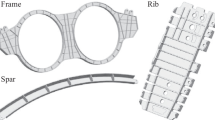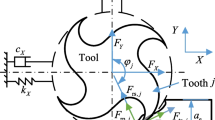Abstract
In this paper, a new approach to modelling the damping parameters and its application in thin wall machining is presented. The approach to predicting the damping parameters proposed in this paper eliminates the need for experiments otherwise used to acquire these parameters. The damping model proposed was compared with available damping models and experimental results. A finite element analysis and Fourier transform approach has been used to obtain frequency response function (FRF) needed for stability lobes prediction. Several predicted stable regions using both experimental and numerical FRF’s for various examples gave a good comparison.
Similar content being viewed by others
References
Taylor FW (1907) On the art of cutting metals. Trans Am Soc Mech Eng 28:31–350
Weck M, Altintas Y, Beer C (1994) CAD assisted chatter-free NC tool path generation in milling. Int J Mach Tools Manuf 34(6):879–891
Tobias SA, Fishwick W (1958) A theory of regenerative chatter. The Engineer, London
Tlusty J, Polacek M (1963) The stability of machine tools against self excited vibrations in machining. Int Res Prod Eng ASME 465–474
Merritt HE (1965) Theory of self-excited machine tool chatter. ASME J Eng Ind 87:447–454
Sridhar R, Hohn RE, Long GW (1968) General formulation of the milling process equation. ASME J Eng Ind 90:317–324
Slavicek J (1965) The effect of irregular tooth pitch on stability of milling. 6th MTDR Conference Manchester
Vanherck P (1967) Increasing Milling Machine Productivity by Use of Cutters with Non-Constant Cutting – Edge Pitch, 8th MTDR Conference Manchester
Tlusty J, Koenigsberger F (1970) Machine tool structures, vol. 1, 5th edn. Pergamon, Oxford
Opitz H (1968) Chatter Behaviour of Heavy Machine Tools, Quarterly Technical Report No 2 AF 61 (052)-916. Research and Technology Division, Wright Patterson Air Force Base, Dayton
Opitz H, Bernardi F (1970) Investigation and Calculation of the Chatter Behaviour of Lathes and Milling Machines. CIRP Ann 18:335–343
Minis I, Yanushevsky T (1993) A new theoretical approach for the prediction of machine tool chatter in milling. ASME J Eng Ind 115:1–8
Minis I, Yanushevsky T, Tembo R, Hocken R (1990) Analysis of Linear and Nonlinear Chatter in Milling. CIRP Ann 39:459–462
Lee AC, Liu CS (1991) Analysis of chatter vibration in the end milling process. Int J Mach Tool Des Res 31(4):471–479
Lee AC, Liu CS, Chiang ST (1991) Analysis of chatter vibration in a cutter – workpiece system. Int J Mach Tool Des Res 31(2):221–234
Altintas Y, Budak E (1995) Analytical Prediction of Stability Lobes in Milling. CIRP Ann 44(1):357–362
Merdol SD, Altintas Y (2004) Multi Frequency Solution of Chatter Stability for Low Immersion Milling, Journal of Manufacturing Science and Engineering. Trans ASME 126(3):459–466
Bravo U, Altuzarra O, Lopez de Lacalle LN, Sanchez JA, Campa FJ (2005) Stability limits of milling considering the flexibility of the workpiece and the machine. Int J Mach Tools Manuf 45(15):1669–1680
Solis E, Peres CR, Jimenez JE, Alique JR, Monje JC (2004) A new analytical–experimental method for the identification of stability lobes in high-speed milling. Int J Mach Tools Manuf 44(15):1591–1597
Lacerda HB, Lima VT (2004) Evaluation of Cutting Forces and Prediction of Chatter Vibrations in Milling. J Braz Soc Mech Sci Eng 26(1):74–81
Budak E, Altintas Y (1998) Analytical Prediction of Chatter Stability in Milling – Part I: General Formulation. Trans ASME 120:22–30
Budak E, Altintas Y (1998) Analytical prediction of chatter stability in milling – Part II: application of the general formulation to common milling systems. Trans ASME 120:31–36
Campa FJ, Lopez de Lacalle LN, Lamikiz A, Sanchez JA (2007) Selection of cutting conditions for a stable milling of flexible parts with bull–nose end mills. J Mater Process Technol 191(1–3):279–282
Adetoro OB, Sim WM, Wen PH (2010) Stability lobes prediction for corner radius end mill using nonlinear cutting force coefficients. Mach Sci Technol, in press
Adetoro OB, Sim WM, Wen PH (2010) An improved prediction of stability lobes using nonlinear thin wall dynamics. J Mater Process Technol 210(6–7):969–979
Thevenot V, Arnaud L, Dessein G, Cazenave-Larroche G (2006) Influence of material removal on the dynamics behavior of thin–walled structures in peripheral milling. Mach Sci Technol 10:275–287
Seguy S, Campa FJ et al (2008) Toolpath Dependent Stability Lobes for the Milling of Thin–Walled Parts. Int J Mach Machinabil Mater 4(4):377–392
Adetoro OB, Wen PH, Sim WM, Vepa R (2009) Numerical and experimental investigation for stability lobes prediction in thin wall machining. Engineering Letters 17(4):257–265, (available at: http://www.engineeringletters.com/issues_v17/issue_4/EL_17_4_07.pdf)
Quintana G, Ciurana J, Teixidor D (2008) A new experimental methodology for identification of stability lobes diagram in milling operations. Int J Mach Tools Manuf 48(6):1637–1645
Quintana G, Ciurana J, Ferrer I, Rodríguez CA (2009) Sound mapping for stability lobes diagram identification in milling processes. Int J Mach Tools Manuf 49(3–4):203–211
Rayleigh L (1878) Theory of sound, 1945th edition. Dover, New York
Caughey TK, O’Kelly MEJ (1960) Classical normal modes in damped linear systems. J Appl Mech 27:269–271
Ewins DJ (1984) Modal testing: theory and practice. Research Studies, Letchworth
Allemang RJ, Brown DL (1986) Multiple input experimental modal analysis – a survey. Int J Anal Exp Modal Anal 1(1):37–44
Mitchell LD (1986) Signal Processing and fast – Fourier – transform (FFT) analyzer – a survey. Int J Anal Exp Modal Anal 1(1):24–36
Brown DL (1982) Modal analysis—past, present and future. Proceedings of the International Modal Analysis Conference & Exhibit
Sanliturk KY, Cakar O (2005) Noise elimination from measured frequency response functions. Mech Syst Signal Process 19(3):615–631
Cakar O, Sanliturk KY (2005) Elimination of transducer mass loading effects from frequency response functions. Mech Syst Signal Process 19(1):87–104
He J, Fu Z (2001) Modal Analysis. Butterworth-Heinemann, Oxford
Altintas Y (2000) Manufacturing automation. Cambridge University Press, New York
Grimes RG, Lewis JG, Simon HD (1994) A shifted block lanczos algorithm for solving sparse symmetric generalised eigenproblems. SIAM J Matrix Anal Appl 15:228–272
Karlsson & Sorensen, Inc. (2006) Hibbitt, Abaqus Theory Manual. Karlsson & Sorensen, Pawtucket
Author information
Authors and Affiliations
Corresponding author
Rights and permissions
About this article
Cite this article
Adetoro, O.B., Wen, P.H. & Sim, W.M. A new damping modelling approach and its application in thin wall machining. Int J Adv Manuf Technol 51, 453–466 (2010). https://doi.org/10.1007/s00170-010-2658-7
Received:
Accepted:
Published:
Issue Date:
DOI: https://doi.org/10.1007/s00170-010-2658-7




